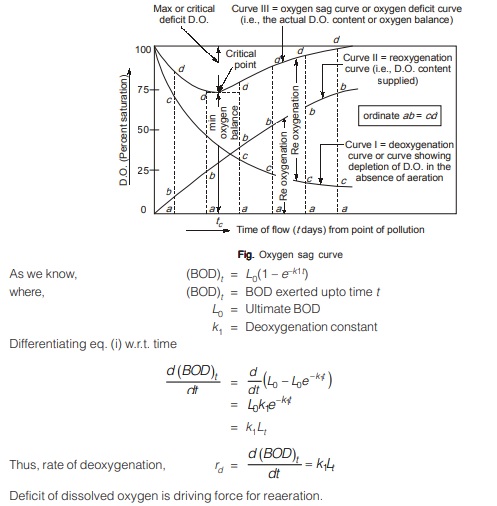Population Equivalent
Average standard BOD of domestic sewage is 80 gms per person per day. The number of person which produce the amount of BOD at the rate of 80 gms per person per day equal to that produced by industrial sewage is called population equivalent of industrial sewage. Industrial wastewater are generally compared with per capita normal domestic wastewater, so as to rationally charge the industries for the population caused by them. The strength of the industrial sewage is, thus worked out as below.

RELATIVE STABILITY
The term relative stability of a sewage effluent may be defined as the ratio of oxygen available in the effluent (as D.O., nitrite or nitrate) to the total oxygen required to satisfy its first stage BOD demand. It is expressed as percentage of the total oxygen required, and can be expressed by the equation.
Relative stability = S = 100 {1-(0.794)t20}
S = 100 {1-(0.630)t37}
where, S = The relative stability, t(20) and t(37) represent the time in days for a sewage sample to decolourise a standard volume of methylene blue solution, when incubated at 20° or 37°C respectively.
The decolourisation caused by the enzymes produced by anaerobic bacteria, infact, is an indication of the available oxygen in oxidising the unstable organic matter.
Aerobic Decomposition
If air or oxygen is available freely to the wastewater in dissolved form, then the biodegradable organic matter will undergo aerobic decomposition, caused by aerobic bacteria as well as by facutative bacteria—operating aerobically. These bacteria will then utilize the free oxygen as electron acceptor, thereby oxidizing the organic matter to stable and unobjectionable end products. The stable end products like nitrates, carbon dioxide, sulphates are formed, respectively for the three forms of matter, i.e., nitrogenous, carbonaceous and sulphurous matter. Water, heat and additional bacteria will also be produced in this biological oxidation, which can be represented by the following equations:
FACTORS AFFECTING SELF PURIFICATION OF NATURAL STREAM
Various factors on which natural forces of purification depends are as follows:
(a) Temperature
The temperature affects the rate of biological and chemical activities, which are enhanced at higher temperature and depressed at lower temperature. The D.O. content of water which is very essential for maintaining aquatic life and aerobic conditions is also influenced by temperature.
Increase in temperature leads to decrease in D.O. and increase in rate of reaction. This is likely to lead to anaerobic condition.
(b) Turbulence
Turbulence in river stream helps in braking surface of stream and helps in rapid re-aeration from atmosphere. Hence, it helps in maintaining aerobic conditions in river stream and in turn keeping it clean.
(c) Hydrography
It affects the velocity and surface expanse of the river stream. Higher velocity and larger surface area leads to greater turbulence and greater dilution of sewage added and helps in self purification.
(d) Amount and type of organic matter
Some compounds can be easily oxidised and some will take time thereby purification will be slow or fast depending on the type of organic matter. Algae which absorbs carbon dioxide and gives out oxygen is thus, very helpful in the self-purification process.
(e) Rate of reaeration
The rate of rearation i.e. rate at which D.O. deficiency is replinshed will govern self purification process. More is the rate of reaeration faster will be the self purification.
Oxygen deficit curve (Oxygen Sag Curve)
Process of deoxygenation and deoxygenation occur simultaneously in a polluted river stream. Deficit of oxygen results when rate of deoxygenation is more than rate of reoxygenation.
The amount of oxygen deficit can be obtained by algebraically adding deoxygenation and re-oxygenation curves as represented by curve-III in figure. The resultant curve is curve oxygen sag curve or oxygen deficit curve. In figure, deficit of oxygen is maximum or critical when rates of deoxygenation and reoxygenation becomes equal.

Hence,
rate of re-oxygenation, rR = –k2D …(ii)
where, k2 = Reoxygenation constant
D = Oxygen deficit
Here, (–ve) sign implies that rate of reoxygenation increases if oxygen deficit decreases.

